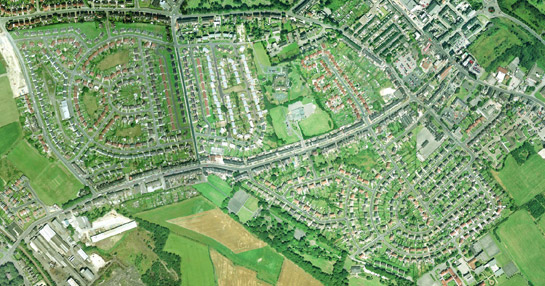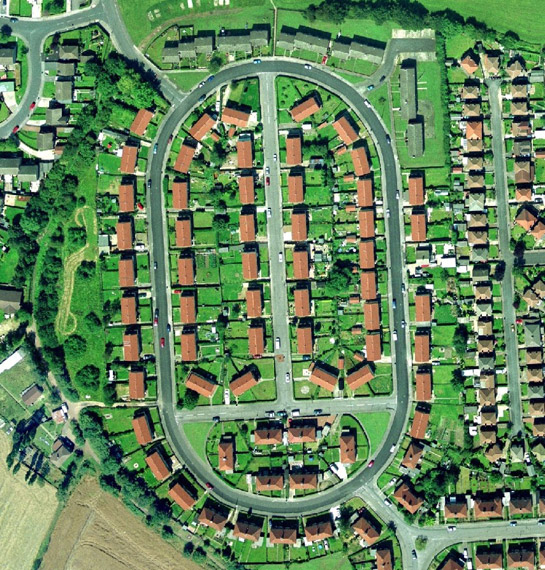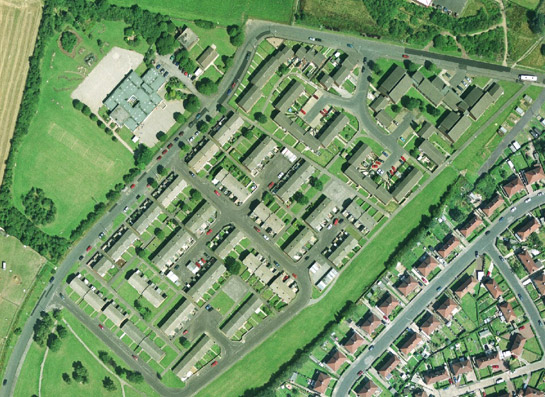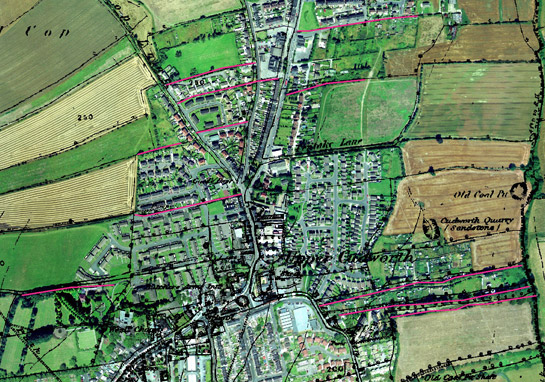Planned Industrial Settlements
Summary of Dominant Character
As the coal seams are near to the surface in the west of the district they could be utilised from an early date and documentary evidence puts coal mining here back as far as the medieval period. These mines left few traces on the landscape and many did not survive long enough to be marked on the 1850s Ordnance Survey maps. This small-scale style of mining continued into the early 19th century, but by the mid 19th century advances in the technologies of transport, ventilation and pumping were beginning to make the exploitation of the deeper seams further east a reality (Hill 2001, 16). This led to a vast increase in mining in the district. Existing coal mines in the area were expanded and new shafts sunk, producing increasing demands for workers. The provision of the initial houses for the workers at collieries in Barnsley was generally the responsibility of single landlords; planned settlements are larger and later examples of such guided development.
The dominant characteristics of this zone largely relate to character areas that developed rapidly prior to 1939, to accommodate miners working on the exposed coal field in central and eastern Barnsley. Also included are the estates built for the workforce at the Iron and Steel works in Penistone and the development of ‘Stairfoot Planned Housing’ and ‘Planned Wombwell’, which were substantially influenced by the nearby glassworks. Some of the settlements within this zone, such as ‘Staincross Common’ and ‘Bolton Upon Dearne Miners Housing’, have only a limited amount of pre-Second World War housing and saw their main expansion between 1960 and 1980. There are also substantial areas of post 1939 development within all of the character areas within this zone.
Many of the settlements within this zone expanded out from late 19th/early 20th century ‘Industrial Settlements’, with their more irregular terraced forms. Other settlements, such as Brierley, Carlton, Kexbrough and Thurnscoe, had, however, developed only a very small area of terraced housing and expansion here was focused on the edge of existing medieval settlements.
This zone is dominated by geometrically planned estates of brick built semi-detached houses, although there are also some short terraces of 4 or 6 houses. This kind of estate design is heavily influenced by the garden city designs of Ebenezer Howard. Howard was working in the late 19th and early 20th century, designing satellite settlements of low density houses with associated shops and recreational facilities (Edwards 1981, 83). Only two ‘Garden Cities’ were built, but the ideas were used in the development of contemporary suburban settlements, particularly those developed by municipal authorities and large scale industrialists.

Figure 1: The south west suburbs of Wombwell showing complex geometric forms.
Cities Revealed aerial photography © the GeoInformation Group, 2002
These types of estate often have radial plans, which frequently make use of concentric circles divided by axial roads. Architectural forms were designed to emulate traditional cottages, all be it in a thoroughly modernised form (English Heritage 2007, 5). Styles favoured to achieve this effect were generally influenced by the Arts and Crafts revival of the late 19th century and the Neo-Georgian school of architecture (ibid). The layout surrounds communal open spaces with cottages in the supposed tradition of English village greens. There was also generous provisions of garden plots.
Fitting within the garden suburbs idea of public recreational space, mining villages also generally feature facilities originally provided by the Miners Welfare Fund. This fund was the product of a levy paid by colliery companies of 1d on every ton of coal produced following the Mining Industry Act of 1920 (Griffin 1971, 170). At colliery sites the fund provided pit-head baths, but within this zone notable features provided are welfare halls, recreation grounds and parks. Team and spectator sports are well catered for, with football and cricket pitches at most recreation grounds. Some grounds also include provision for tennis and bowling. Large areas of allotment gardens can also be seen on the 1930s OS plans of these settlements.
With the nationalisation of the coal industry in 1947 (Hill 2001, 36), all assets of the former colliery companies, including 140,000 houses nationally, passed to the new National Coal Board (Beynon, Hollywood and Hudson 1999, 2). The NCB continued to take a role in the construction of housing estates to attract workers to colliery communities, although from 1952 this role was undertaken in partnership with local authorities (ibid). In this zone, the majority of residential development up to 1976 (when the NCB withdrew from the provision of miners housing (ibid, 3)) was provided as part of large-scale social housing schemes [generally characterised at character unit level by this project as ‘Planned Estate (Social Housing)] undertaken by the public sector. Until the 1970s development led by the private sector was generally small-scale, and mostly consisted of ribbon development along main roads. Later developments within this zone have superficial characteristics in common with the earlier estates, however the open spaces of the earlier estates became less common and the developments tend to increase in housing density. Houses may also be built from cheap building materials, as with the corrugated metal homes in part of the ‘Royston Miners Housing’ area.

Figure 2: Central Drive, south Royston. Cheaply constructed houses built within the same housing layout as earlier brick built homes.
Cities Revealed aerial photography © the GeoInformation Group, 2002
Some of the later housing developments within this zone moved away from providing private space around the houses, to open plan estates based on the Radburn principles of design. These layout principles, originating in a study by US architects Stein and Wright of English garden suburb planning (Sheffield City Council 1962, 12) aimed to maximise the separation of vehicles and pedestrians by avoiding points at which pedestrians would have to cross vehicle carriageways. Instead of facing on to carriageways, houses were designed to front directly onto common green spaces, without privately demarcated enclosed gardens.
The Radburn estates built across this zone in this period are typical of many developed nationwide from the 1950s through to the late 1970s. Houses of this type are generally constructed according to system building techniques, typically the ‘No Fines’ method developed by Wimpey. Houses built in this system were cast in situ from a concrete mix requiring no ‘fine’ aggregates, i.e. cement and gravel. This method could be executed quickly and cheaply, however, the resulting aesthetics of the properties, which were finished with quickly applied render, are generally regarded as bleak. Structural problems with this method of system building include poor thermal insulation and condensation.

Figure 3: Radburn-type estate: Billingley View, west Bolton-upon-Dearne.
Cities Revealed aerial photography © the GeoInformation Group, 2002
More recent urban design theories have turned away from the open plan concept of these estates, as they are now believed to offer no defensible space, whilst the common parking areas provided to the rear of properties have been criticised as “poorly overlooked and magnets for anti-social behaviour” (CSR Partnership 2004, 26). Estates of these design are fairly low in number in Barnsley, however, with most planned industrial estates conforming, at least partially, to the geometric garden suburb styles of the earlier period.
Relationship to Adjacent Character Zones
The most obvious relationship between this zone and others is with the ‘Industrial’, ‘Extractive’ and ‘Post Industrial’ zones where the sites of the commercial concerns that influenced the development of these ‘Planned Industrial Settlements’ are located. This link with industry also means that settlements were located near to the numerous railway lines that ran across the district and in proximity to the Dearne & Dove Canal and the Barnsley Canal. Many of these transport links were removed in the mid to late 20th century, but some railway lines remain as do sections of the canals.
There are many comparisons that can be made between the ‘Industrial Settlements’ zone and ‘Planned Industrial Settlements’. Like many of the estates within this zone, most of the ‘Industrial Settlements’ were developed to house a mining population. However, the planned settlements have a greater level of organisational planning and the developments are built on a larger scale. There are streets within the ‘Planned Industrial Settlements’ zone that have more irregular characteristics, but these are too small to pull out and discuss as a separate zone. Many of the ‘Planned Industrial Settlements’ developed around earlier ‘Industrial Settlements’ and all of the character areas of this zone abut or are located close to historic villages described by this project under the ‘Nucleated Rural Settlements’ zone description.
Inherited Character
Within this zone, character relating to earlier landscapes is generally rare. As with the similar housing forms of the ‘Municipal Suburbs’, the geometric housing patterns tend to overwrite much of the previous landscape. This is particularly true where the planned settlements have been developed rapidly on a large scale.
Colliery settlements developed on a broad range of rural landscape types; 89% of the housing in this zone was built on agricultural land. The main features of the past landscape partially visible within the current housing estates are historic enclosure boundaries and earlier rural lanes. These are generally seen along boundaries of various phases of development or along the edges of housing estates. The close proximity of many of these settlements to medieval villages, however, means that enclosed strip fields and medieval crofts account for nearly half of this enclosed land. Strip field patterns associated with former medieval agricultural systems (see ‘Strip Enclosure’ zone for further detail) can be seen at ‘Brierley Colliery Housing’, ‘Carlton Miners Housing’, ‘Cudworth Miners Housing’, ‘Goldthorpe and Bolton-upon Dearne Expansion’, ‘Great Houghton Colliery Housing’, ‘Hoyland, Jump and Elsecar Planned Expansion’, ‘Penistone Industrial Expansion’, ‘Royston Miners Housing’ and ‘Thurnscoe Colliery Village’. Crofts are the long thin enclosures that run behind medieval buildings fronting the main village street and at Dodworth these are partially preserved by the edges of the miners welfare ground and in the boundaries at the edge of Dodworth Primary School.

Figure 4: Upper Cudworth - some strip field boundaries are fossilised within the ‘Planned Industrial Settlements’ zone (emphasised in pink).
1854 OS map © and database right Crown Copyright and Landmark Information Group Ltd (All rights reserved 2008) Licence numbers 000394 and TP0024 overlying Cities Revealed aerial photography © the GeoInformation Group, 2002
As mentioned above, many of the settlements within this zone expanded from earlier irregular ‘Industrial Settlements’. This is the case for housing around Nether Hoyland and Elsecar, which resulted in the ‘Industrial Settlements’ of Hoyland Common and Elsecar becoming agglomerated. There was also an industrial settlement at Jump, formed in the 19th century to house a colliery workforce. Most of the terraces of houses were largely replaced by a park and social housing in the 1980s, although there are still some surviving 19th century terraces and a surviving street layout incorporated within the later planned industrial settlement.
Later Characteristics
All of the settlements within this zone were closely associated with industry, especially with coal mining. The 1970s saw a gradual reduction in the number of pits as sites were rationalised and combined. The major closures started in the 1980s, with the last colliery in Barnsley closing in 1992 (Yorkshire Forward 2003, 17). These closures were fought against by the vast majority of the local working population (Adeney and Lloyd 1985). The eventual closures left communities with substantial numbers of unemployed people and a landscape of derelict industrial sites.
The NCB had disbanded the Coal Industry Housing Association in 1977 and had been selling off its housing at a gradual rate, but this was to increase substantially after the miners strike of 1984-5. Much housing had been transferred to the municipal authority or sitting tenants, but the late 1980s saw the sale of housing to private landlords (Beynon, Hollywood & Hudson 1992, 3). There are still large numbers of council owned housing within this zone, but there is still a move towards more private ownership; this is in line with national trends (Office for National Statistics 2004, 30).
Barnsley, like much of the surrounding region, received substantial grants from the European Union in the 1990s to reverse the effects of economic decline (Government Office for Yorkshire and the Humber 2007). This funding has been ongoing and has been used to reclaim disused land, bring business into the area and improve housing in former colliery settlements. These changes are not always seen directly within this zone as often the areas of housing removed and replaced are within the earlier ‘Industrial Settlements’ zone. Examples of improvement within the zone include the demolition of early terraces on the edge of Staincross and the regeneration of a former brickworks on the edge of Thurnscoe. Both these sites have been redeveloped into public parks.
Throughout the zone small private estates have also been built, sometimes infilling between earlier developments, or built on the edge of the settlement. Other later developments within this zone include improvement of green spaces, expansion of schools, establishment of a modern sports centre and the creation of a number of nursing homes.
Character Areas within this Zone
Map links will open in a new window.
- Bolton Upon Dearne Miners Housing (Map)
- Brierley Colliery Housing (Map)
- Carlton Miners Housing (Map)
- Cudworth Miners Housing (Map)
- Darfield Planned Housing (Map)
- Darton and Kexbrough Miners Housing (Map)
- Dodworth Colliery Housing (Map)
- Goldthorpe and Bolton Upon Dearne Expansion (Map)
- Great Houghton Colliery Housing (Map)
- Grimethorpe (Map)
- Hoyland, Jump and Elsecar Planned Expansion (Map)
- Middlecliff (Map)
- Penistone Industrial Expansion (Map)
- Planned Wombwell (Map)
- Royston Miners Housing (Map)
- Shafton Miners Housing (Map)
- Staincross Planned Colliery Housing (Map)
- Stairfoot Planned Housing (Map)
- Thurnscoe Colliery Village (Map)
Bibliography
- Adeney, M. and Lloyd, J.
- 1985 The Miners Strike 1984-5: Loss Without Limit. London: Routledge.
- Beynon, H., Hollywood, E., and Hudson, R.
- 1992 Regenerating Housing: Coalfields Research Programme, Discussion Paper 6. Cardiff, Cardiff University Available from: www.cardiff.ac.uk/socsi/resources/regenerating%20housing%20-%206.pdf [accessed 16/04/08].
- CSR Partnership
- 2004 Masterplanning at Royal: Granby: Howbeck Estates, Edlington. CSR Partnership for Doncaster MBC / Transform South Yorkshire. Available from: www.doncaster-community.co.uk/Living_in_Doncaster/Homes_and_Housing/HMR_pathfinder/edlington/Masterplans_for_Edlington.asp [accessed 16/04/08].
- Edwards, A.M.
- 1981 The Designs of Suburbia. London: Pembridge Press.
- English Heritage
- 2007a The Heritage of Historic Suburbs [online]. London: English Heritage. Available from: www.helm.org.uk/upload/pdf/Heritage-Suburbs.pdf [accessed 16/04/08].
- English Heritage
- 2007b The Modern House and Housing: Selection Guide – Domestic Buildings (4) [online]. London: English Heritage, Heritage Protection Department. Available from: www.english-heritage.org.uk/upload/pdf/Domestic_4_Modern_House_and_Housing.pdf [accessed 16/04/08].
- Government Office for Yorkshire and the Humber
- 2007 Objective 1 [online]. Government Office for Yorkshire and the Humber. Available from: www.gos.gov.uk/goyh/eurofund/o1/ [accessed 17/04/08].
- Hill, A.
- 2002 The South Yorkshire Coalfield: A History and Development. Stroud: Tempus Publishing Ltd.
- Office for National Statistics
- 2004 Living in Britain: Results from the 2002 General Household Survey [online]. The Office for National Statistics. Available from: www.statistics.gov.uk/lib2002/ [accessed 01/04/08].
- Sheffield Corporation
- 1962 Ten Years of Housing in Sheffield. Sheffield: Sheffield Corporation, Housing Development Committee.
- Yorkshire Forward
- 2003 Remaking Barnsley: Strategic Development Framework 2003-2033 [online]. Available from: www.remakingbarnsley.co.uk/ [accessed 16/04/08].
